Healthcare Assignment: How Consumption of Red & Processed Meat Increase Risk of Cancer?
Question
Task: Prepare a literature review report on healthcare assignment critically analysing the topic “Consumption of red meat and processed meat and cancer in Hong Kong”.
Answer
1. Introduction
According to the viewpoint of Red and processed meat Cancer Council NSW. (2021) undertaken in this healthcare assignment, in the history of medical sciences there is strong evidence we can find which shows that consuming processed red meat causes serious cancer and health hazards. There are many researchers throughout Australia investigating red meat consumption and their impact on the health of people. Bowel cancer caused by red meat consumption is mostly found in Australia where the process to cure it and make people aware of consuming red and processed meat has been discussed in this paper by considering the research study. Bowel cancer or colorectal cancer is considered as the third common cancer in all over the world and second common for women. According to the viewpoint of the World Health organization (WHO), in their GLOBOCAN 2012 database, more than half cases of this cancer have been developed in cities and industrial countries. In this literature review meta-analysis of epidemiological studies about the consumption of red and processed meat and the corresponding CRC risk has been observed with the understanding of actual recommendations and mechanism of local and international guidelines. The use of red process meat is gradually increasing in Hong Kong as well as throughout the globe and it has increased the chance if health risk.
2. Literature Analysis
2.1 Red meat and health risk
As per the analysis made by Aykan, (2021), cancer caused by Red meat and processed meat consumption has been increased worldwide. Considerable impact of Red meat in CRC or colorectal cancer has been found from low risk to high risk specifically in the areas where people adopt improved and advanced lifestyle and consuming red and processed meat as their daily meal. In modern era both the Economic and social lifestyle are changing with the passing time. More the people avoiding healthy food and vegetables and started eating processed meat they face serious health hazards. As per the report What’s the beef with red meat? - Harvard Health. Harvard Health. (2021), red meat including beef, pork, veal, mutton and lamb are mostly included in Western diets around the developed countries. A recent study Qian et al., (2021), published in the year 2019 has been shown that eating red meat does not always lead to health risks depending on how much and to what extent a person is taking it. Health issues caused by eating too much red and processed meat is mostly bad for the persons who have heart disease, who are diabetic and also have other serious health issues. As per the research evidence, an accumulated human body with higher intake of processed meat also causes premature death.
A team of medical sciences are concerning with the health hazards incurred for red meat consumption where it has been identified that eating red and processed on daily basis causes bowel cancers and also shorten the life span. people also faces risks like cardiovascular disease with the cancer and this have pointed out an elevated hazard of health and increase mortality rate.
Weight gain: Processed red meat is prepared from freezing the marinated and ready to cook red meat which causes issues like weight gain. Fat is considered as the rich source of energy and in taking 1 gram of fat leads to an increase of 9 kcal energy to a human body. It has been postulated that intake of saturated fatty acids which people can have from red processed meat at their dinner or lunch causes weight gain and results in obesity. As per the study of a US medical team that both processed or direct red meat causes obesity. It has been observed that after multivariable adjustment increasing red meat consumption leads to an increase of 0.95 pounds’ weight.
Cardiovascular disease: as per the analysis made in recent science research, consumption of red and processed meat contribute to cardiovascular disease to the relative high quality content of saturated fats and that impact in cardio protective nutrients like omega-3 fatty acids and others. Low density lipoprotein which contains high cholesterol leads to the risk of atherosclerosis.
Type 2 diabetes
As per the study Pan et al., (2011), saturated fatty acids which impaired in insulin sensitivity affect glucose uptake and also cause an increasing risk of type two diabetes. Risk of diabetes also causes stroke and uncertain death. It has been considered that people who lead modern lifestyles and have bad or more processed meat taking habits on a daily basis along with smoking and alcohol cause type 2 diabetes and stroke with hypertension and high blood cholesterol.
2.2Process Meat and Bowel Cancer risk in Hong Kong
As per the study made by Hong Kong Cancer Registry, Hospital Authority, (2021), bowel or colorectal cancer caused by in taking red and processed meat is considered as a malignant neoplasm which effects the lower gastrointestinal tract specifically found in Hong Kong .In Hong Kong bowel cancer ranked as second common cancer disease where 4335 cases have been found in the year 2009 and in the year 2010 1864 seats due to colorectal cancer in Hong Kong has been reported in Red and processed meat. Cancer Council NSW, (2021). Medical study in Hong Kong stated that most of the men who have faced this cancer disease at their middle age. Various kinds of cancer disease have been found worldwide and the reasons behind this are also different. Colorectal or bowel cancer is considered to be due to diet or lifestyle related therefore people can avoid bowel cancer only by changing their lifestyle, food habits where red meats are suggested to avoid in daily meal diet. As per the recent data Cancer Statistics, (1983-2011), the number of the cases of colorectal cancer are increasing on a daily basis along with the number of deaths due to people's unnecessary avoidance to have a balanced diet and red meat (Chan et al., 2011). Excessive red and processed meat consumption with the smoking and drinking habits causes deaths as the ultimate of their destiny. For Analyzing the State of Hong Kong by considering cancer disease it has been observed that both men and women died due to the killer disease of cancer where the percentage of cancer has been increased to almost 80% in the last few decades. Among the other cancers in Hong Kong, 18.1% of men are having colorectal cancer and 14.8% women are having the same.
According to the study Mortality Statistics, (1981-2012), colorectal cancer has various risk factors which occur when the cell grows in rectum or colon. Colon or rectum is considered as the last place of the digestive system or tract. This increasing unnatural cell over the rectum disrupts the overall digestive tract and causes serious health issues. Though bowel cancer is curable to some extent with advanced medical sciences technology, the treatment results only for 50% of the patients where there is less chance of recurrent disease or incurring death. Bowel cancer is developed from polyps and then increased through an inner lining of the colon and affects the rectum and colon. According to the report presented in Hong Kong Cancer Registry, Hospital Authority, (2021), Hong Kong cancer registry was established in 1963 and it was a population based registry which committed to collect and conduct the analysis of the country's cancer cases, rate of recovery, Percentage of death and regarding health care solutions. People who lived in China or more specifically in Hong Kong preferred to have rich protein in their daily meal and as per the study red meat contains a high proportion of protein source included in their diet. They like to have more beef, pork and other meats as their breakfast, lunch or dinner. People of Hong Kong have a minimum of 220 and maximum of 275 gm per day. This consumption of high rich protein on a daily basis leads to a high chance of colon cell extension which causes cancer in the colon or rectum of the human body. Hong Kong is also known as a busy country and people spend their day at work and less time in cooking for the reason they purchase processed food especially meat from supermarkets and make meals for them by only microwaving it. Development of Bowel cancer or also termed as CRC can be found as a result of multiple epigenetic or genetic changes which results in colon carcinoma through the activation and inactivation of oncogenes and rumon suppressor genes respectively. In this process of colon cancer most of the people in the country face somatic mutations where they face difficulties in digestion and issues in bowel movement
3. Application of Research Method
3.1 Observation/Question
The overall research method has been conducted based on secondary research which uses several articles and peer reviews on the topic of consumption of red meat. The scientific research has been conducted by the researchers. Therefore, from the research it can be observed that the processed or unprocessed red meat causes cancer in the human body. In the market, fermentation, curing, and salting are the processes used to enhance the tastes of meat. The consumption of processed meat has been classified as carcinogenic to humans based on the working group. Throughout the socio economic factors the type as well as amount of red meat consumed which has varied widely and the religious beliefs, political influences and geographical differences influence the consumption of red meat. Based on the study, in Europe 24 hour dietary recalls over more than 36000 subjects aged 35 years to 74 years in hiring from 27 countries all over the 10 countries involving Denmark, Germany, UK. The report mentioned that the red meat was consumed about 24 g to 57 g per day by the woman whereas 40 g to 121 g per day by men. As opined by Luan, Wu, Gong et al., (2013), in the centre of Italy, France and Northern Spain the take of beef and mutton was highest on the other hand, meat consumption regarding per capita has dropped in the US. Therefore, in the survey of the National Health and Nutrition Examination, red meat was still represented in the largest proportion which has been measured about 58 percent.
3.2 Area of Research Topic
The research topic discusses the red meat consumption that causes cancer and other diseases in the human body. It has been researched that red meat is one of the best sources of important nutrients that evolve protein and work on the maintenance and repair of body tissue, regulations of hormones as well as enzymes. In addition, as opined by Xie&Itzkowitz (2008), making a healthy nervous system along with proper cell growth vitamins B6 and B12 are the necessary elements whereas omega fatty acids contribute to brain function of the human body. As per the research, eating too much red meat can cause weight gain, cardiovascular diseases, colorectal cancer or type 2 diabetes. The compounds of n-nitroso and heterocyclic amines formed in the process of high temperature cooking. Indeed, such compounds which are present in red meat have been theorised to boost DNA synthesis and affect the hormone metabolism that cause radical damage in human body tissue. It has been evidenced that red meat consumption increases the risk of cancer such as breast, pancreas, and lung, liver in prostate in men or endometrium in women. However, biomedical factors or several behavioural factors influence the risk of cancer development; moreover, the adaptation of unhealthy lifestyles can increase about 40 percent of cancer deaths in Hong Kong.
3.3 Hypothesis
From this point of view Chen, Chen, & Liu, (2020), based on a particular property of a population a research hypothesis can be recognized as a clear, specific, testable proposition or predictive statement over the possible outcome that conducts presumed differences between particular variables and groups. In the research, the most serious human affliction of cancer is widely known as a non-communicable disease. Therefore, over 8.2 million cancer-related deaths have been placed in 2012 all over the world although the new cases of cancer were estimated at about 14.1 million. Liver and stomach cancer cause the most death cases and the research found that drinking alcohol is another cause of cancer that impacts families as well as individuals that devastates society also. Therefore, there are 100 types of cancers that have several patterns, behaviour and gene structure. In 2012, cancer was also the leading cause of death which was estimated to be about 8.2 million deaths that were 13 percent of all deaths. Stomach cancer precedes lung cancer and breast cancer. It has been predicted that over 19.3 million cancer cases would be increased by 2025. However, in accordance with the doctor’s advice people should get vaccinated for HPV and HBV to prevent cancer disease.
3.4 Tests with Experiment
In making the test, the research team utilizes the scientific experiment and performs secondary data collection from the relevant websites and peer reviews. The research over cancer due to red meat consumption utilizes several data records and experiments of the previous circumstances. Chilled and frozen are the kinds of beef and pork that are the usual diet of Hong Kong people and the report stated that beef consumption increased about 46.9 kg in 2002 from 42.2 kg in 1982. Therefore, the per capita ratio of pork consumption to beef consumption rose from 3:3:2 to 4:5:1. Including the red meat of the Hong Kong adults who are aged 20 to 84 years the food consumption survey investigated the food consumption in Hong Kong which mentioned that sheep, beef and pork were consumed .71 g, 15.06 g and 53.81 g per day respectively (Nguyen et al., 2009).
3.5 Analyze Data
`Analyzing the data of the study it can be suggested that consumption of red meat increases the risks of chronic disease where red meat contains significant nutrients for the functioning of the normal body. Therefore, it increases the risks factors of health which is included that food contamination, unsafe sexual behaviours, ionization radiation, alcohol use, obesity, physical inactivity in the health care settings. According to both of the figures, it can state that about 14.1 million new cases are diagnosed whereas 8.2 million deaths were recorded in 2012.
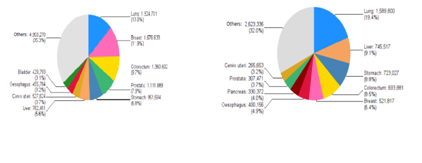
Figure 1: The pie chart of cancer cases and death all over the world
(Source: D'Elia , Rossi , Ippolito et al., 2012)
3.6 Report Conclusion
However, in conclusion, it can be said that cancer awareness is required and the medical field has to implement advanced technology to maintain a balanced diet avoiding the risk factors. Hence, the report analyses the data and optimizes the value of future research.
4. Statistical Analysis (Secondary) based on the material and test method

Figure 1: Consumption of red meat as per week by people aged 18-64 for all gender
Source: (Chp.gov.hk. 2021)
In the above graphical representation consumption of red meat as per gender has been shown with the proportion of red meat consumption.it has been observed that 49% of men aged between 18-64 consume red meat as their daily meal followed by 45.8% women who eats red meat on daily basis in the world wide. Study also shows that 25.1% of women consume red meat 4-6 days per week followed by men 23.5% who consume processed meat for 4-6 days.24.4% of every gender having red meat for 1-3 days where the consumption of red meat to a negligible extent is extremely low. Only 5.2% of women and 2.6% of male consume red meat in less than 1 day or not having meat. Patterns of red and processed meat consumption: as identified in the recent studies based on the investigation of people's preferences of having red and processed meat and results they face. People face serious health issues due to the intake of red meat as it changes their lifestyle, bowel movement and other health standards. Expert panel belonging to the world cancer research fund AICR reported that excessive consumption of red meat is directly related with colon cancer. A version of metal analysis in the year 2011 shows that increasing every 100 gm of red meat consumption in daily meals can also increase the chance of colorectal cancer among human beings by 17% (Colorectal Cancer Statistics, 2021). Investigation in Europe has been made on the basis of middle to old age groups like 35-74 years belongs to almost 10 countries including France, Italy, Spain, Greece, China, UK, Netherlands, Denmark and Sweden in the early decade to identify how much this specific age group intake meat. It has been observed that mostly men intake most of the processed red meat proportion which was reported as 50-125 gm per day and up to 60gm for women. Pork and beef are the most common meat consumed by these people.
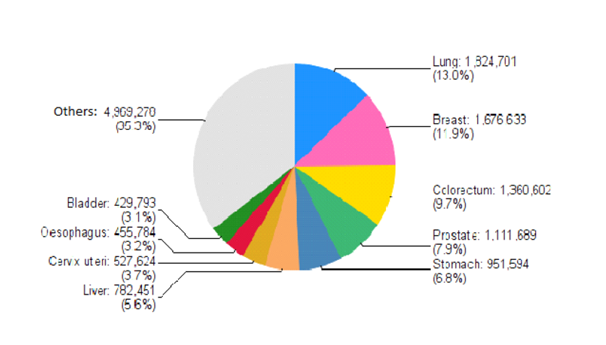
Figure 2: Estimated new cancer cases in 2021 worldwide (For all age and gender)
Source: (Globocan 2012)
As per the report in 2012 there are almost 14.1 million new cancer cases in the overall world where 9.7% people had colorectal cancer which is almost 136002. Colorectal cancer in Worldwide belongs to 2nd position only after lung cancer irrespective of age or any gender. With the up gradation of medical sciences these types of cancer are curable but almost 8.5% of total 8201030 deaths have happened all over the world due to colorectal cancer. Colorectal cancer is mostly happening due to unhealthy diet where red and Processed meat are included in daily meal.30% of this cancer is identified in developed countries where only 20% have been found in developing countries. People replaced their healthy food diet including vegetables and fruits with red meat.it have been proved that only 5% of person who eats vegetables and fruits and avoid red meat are going through cancer due to some uncertain reasons like pollution, genetics and others. More than 50gm of red meat every day causes 17-18% of colorectal cancer risk Red and processed meat. Cancer Council NSW. (2021). Processed red meats are the worst as they are made with unnatural food color, chemical, spices and preservatives.
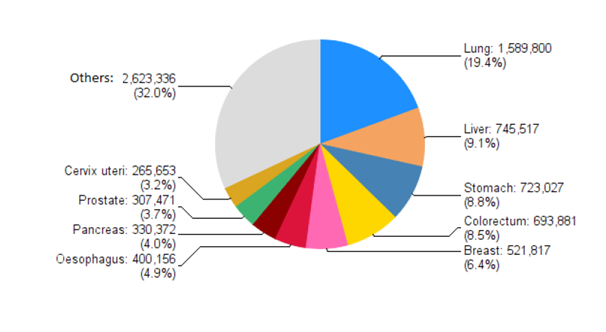
Figure 3: (Estimated number of deaths due to colon cancer for all age and gender in 2012)
Source: (Globocan 2012)
Colon cancer can be prevented by adopting some of the major rules of healthy lifestyle by having healthy food in the diet and avoiding red meat consumption to an extent. As per the research made by the World health organization (WHO) it has been identified that more than 40% of the cancer deaths is curable if people modify the risk factors by following special diet chart.
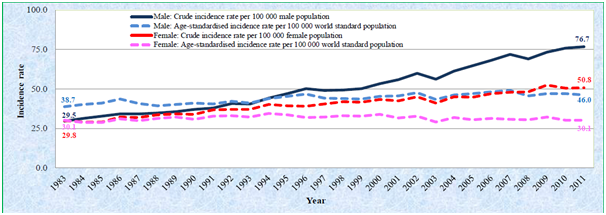
Figure 4: Crude and age-standardised incidence rates of colorectal cancer for male and female
Source: (Murphy et al., 2012)
Among other countries in the world Hong Kong faces a serious burden of colorectal cancer where people are having colorectal cancer more than lung cancer which is highest in the world wide.in this country 4450 cases have been observed in the year which is almost 16.5%. Most of the people who have colorectal cancer in this country are men and aged 50 or above. As per the above graphical analysis crude incidence rate has been found which is 76.7% for men and 50.8% for women among the total 100000 populations. Considering the above graph, it has been observed that for females in the country, the standardised incidence rate per 100000 increased from 29.8% in 1983 to almost 30.1% in the year 2011(Globocan 2012).
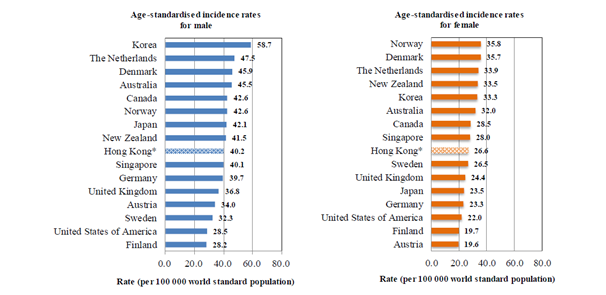
Figure 5: International comparison of age-standardised incidence rates of colorectal cancer for men and women
Source: (Hong Kong Cancer Registry, Hospital Authority. Www3.ha.org.hk. (2021)
In the above diagram international comparison of age standardised incidence rates for colorectal cancer has been made as per world analysis in the year 2012. According to the study of Globocan 2012, the international agency for research based on cancer and others in Hong Kong observed that people having colorectal cancer can live for 5 years on a serious note. Survival rate of colorectal cancer patients has been reduced from 90% to 69% when cancer started spreading beyond the rect and colon and spread to other adjacent human organs. In earlier stages the cancer is considered as the second cause of cancer deaths in the country after lung cancer but it has been increased to 1903 registered deaths which were attributed to 14.3% of deaths. As per the report of 2011 the rate of cancer has been reached to 48.6% which were diagnosed in third or fourth stage in the country.
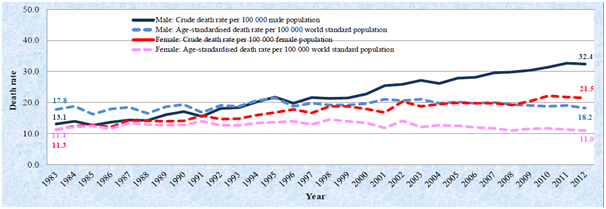
Figure 6: Crude and age-standardised death rates of colorectal cancer for male and female
Source: (Hong Kong Cancer Registry, Hospital Authority. Www3.ha.org.hk. (2021)
It has been observed that age standardised death rate by colorectal cancer in the country Hong Kong is considered to be around 46% higher than the death rate of worldwide. Where in Hong Kong the death rate is 12.1%per 100000 world standardized population, the global rate is 8.3% per 100000.
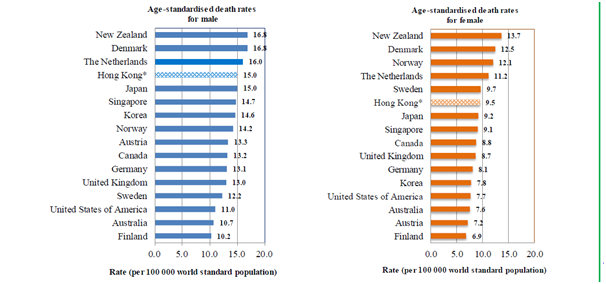
Figure 7: International comparison of age-standardised death rates of colorectal cancer for men and women
Source: (Globocan 2012)
As per the above graphical representation age standardized death rates for men due to having colorectal cancer is highest in New Zealand and Denmark which is almost 16.8 per 100000 standard populations and lowest in Finland which is almost 10.2. the rate in Netherlands and Hong Kong is also not avoidable which are 16 and 15 per 100000 populations respectively in case of world's men. The age standardised death rates for female can also be identified where New Zealand ranked in top most positions at 13.7 per 100000 worlds standardized population followed by Denmark which is reported as 12.5. Though the rate is lower in case of female than male but it's not avoidable. Due to having excess amount of red meat and processed meat 9.5 per 100000 populations in Hong Kong died.
13% of the total bowel cancer cases can be curable only by changing lifestyles and more than 23% cases can also be prevented by following some restrictions. Having 5 seasonal fruits and vegetables on a per day basis and eating more if whole grains and unprocessed meals cutting down red meat to higher extent can prevent cancer.it has been proved that 9-11% of colorectal cancer risk have been prevented only by having 10gm of high fibre Vegetables and any kind of seasonal fruits. As per the report Boyle et al., (2012) 27% of people who have been cured from proximal colorectal cancer only by regular exercise and avoiding red meat consumption and 26% of people who have been cured from distal colon cancer by physical activities. The United Nations has identified the matter of bowl cancer as serious issue and the medical development has been developed throughout the globe.
5. Conclusion
At the end of the report of colorectal or bowel cancer and red and processed meat consumption the conclusion can be made where the entire evaluation linked with red and processed meat consumption and different analyses of colorectal cancer have been made. In the report the study of literature review of red meat and colorectal cancer has been obtained with different ranges of study analysis. With the application of research methods, test analysis and statistical observations it has been evaluated that consuming red and processed meat is not healthy and with the regular intake of these kinds of meal can cause serious health issues, cancer and ultimate death. Crude and incidence analysis of colorectal cancer and processed meat consumption have been made on the basis of some statistical observations linking with graphs, charts and tables. Hong Kong is considered as the centre country to make the analysis by comparing the cancer and corresponding curable rate with the global analysis. Colon or bowel cancer can only be prevented with the adoption of a healthy lifestyle where people are ready to avoid red and processed meat in their daily meal and can shift to intake of vegetables and fruits. In the above research study, the overall estimation of red meat consumption and colon cancer has been made with the real term analysis.
Reference
Aykan, N. (2021). Red meat and colorectal cancer. Retrieved 25 November 2021, from.
Boyle T, Keegel T, Bull F, et al. (2012). Physical activity and risks of proximal and distal colon cancers: a systematic review and meta-analysis. J Natl Cancer Inst.104(20):1548-61.
Cancer Statistics, (1983-2011). Hong Kong SAR: Hong Kong Cancer Registry of Hospital Authority and Census and Statistics Department Chan DS, Lau R, Aune D, et al. (2011) Red and processed meat and colorectal cancer incidence: meta-analysis of prospective studies. PLoS One6(6):e20456.
Chen, L., Chen, T. L., & Liu, H. K. (2020). IDENTIFYING STUDENTS'PERCEPTION OF CLICKERS VIA BRING YOUR OWN DEVICE (BYOD) IN FLIPPED CLASSROOMS.International Journal of Organizational Innovation (Online), 13(1), 105-117. Chp.gov.hk. (2021). Retrieved 25 November 2021, from https://www.chp.gov.hk/files/pdf/brfa_report_april_2016_eng.pdf.
Colorectal Cancer Statistics, (1983-2011). Hong Kong SAR: Hong Kong Cancer Registry, Hospital Authority
D'Elia L, Rossi G, Ippolito R, et al. (2012) Habitual salt intake and risk of gastric cancer: a meta-analysis of prospective studies. ClinNutr 2012;31:489-98.
Globocan(2012). Lyon: International Agency for Research on Cancer.
Hong Kong Cancer Registry, Hospital Authority. Www3.ha.org.hk. (2021). Retrieved 25 November 2021, from https://www3.ha.org.hk/cancereg/. Luan NN, Wu QJ, Gong TT, et al.(2013) Breastfeeding and ovarian cancer risk: a meta-analysis of epidemiologic studies.Healthcare assignment Am J ClinNutr 2013; 98(4):1020-31.
Mortality Statistics, (1981-2012). Hong Kong SAR:Department of Health and Census and StatisticsDepartment.
Murphy N, Norat T, Ferrari P, et al. (2012) Dietary fibre intake and risks of cancers of the colon and rectum in the European pro-spective investigation into cancer and nutrition (EPIC). PLoS One. 7(6):e39361. Nguyen SP, Bent S, Chen YH, Terdiman JP. (2009) Gender as a risk factor for advanced neoplasia and colorectal cancer: a systematic review and meta-analysis. ClinGastroenterolHepatol 7 (6):676-81 e1-3.
Pan A, Sun Q, Bernstein AM, et al. Red meat consumption and risk of type 2 diabetes: 3 cohorts of US adults and an updated meta-analysis. Am J ClinNutr (2011);doi:10.3945/ajcn.111. 018978.
Qian, F., Riddle, M., Wylie-Rosett, J., & Hu, F. (2021). Red and Processed Meats and Health Risks: How Strong Is the Evidence. Retrieved 25 November 2021, from.
Red and processed meat. Cancer Council NSW. (2021). Retrieved 25 November 2021, from https://www.cancercouncil.com.au/cancer-prevention/diet-exercise/nutrition-and-diet/meat-and-cancer/.
Risk in Red Meat. National Institutes of Health (NIH). (2021). Retrieved 25 November 2021, from https://www.nih.gov/news-events/nih-research-matters/risk-red-meat.
What’s the beef with red meat - Harvard Health. Harvard Health. (2021). Retrieved 25 November 2021, from https://www.health.harvard.edu/staying-healthy/whats-the-beef-with-red-meat.
Xie J, Itzkowitz SH. Cancer in inflammatory bowel disease. World J Gastroenterol 2008; 14(3):378-89.












